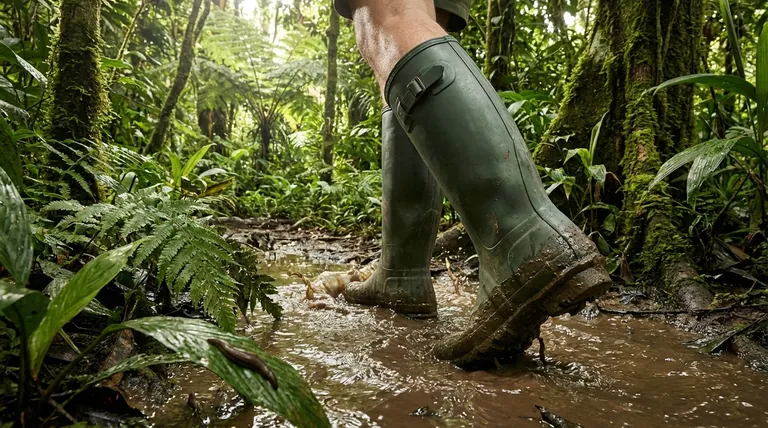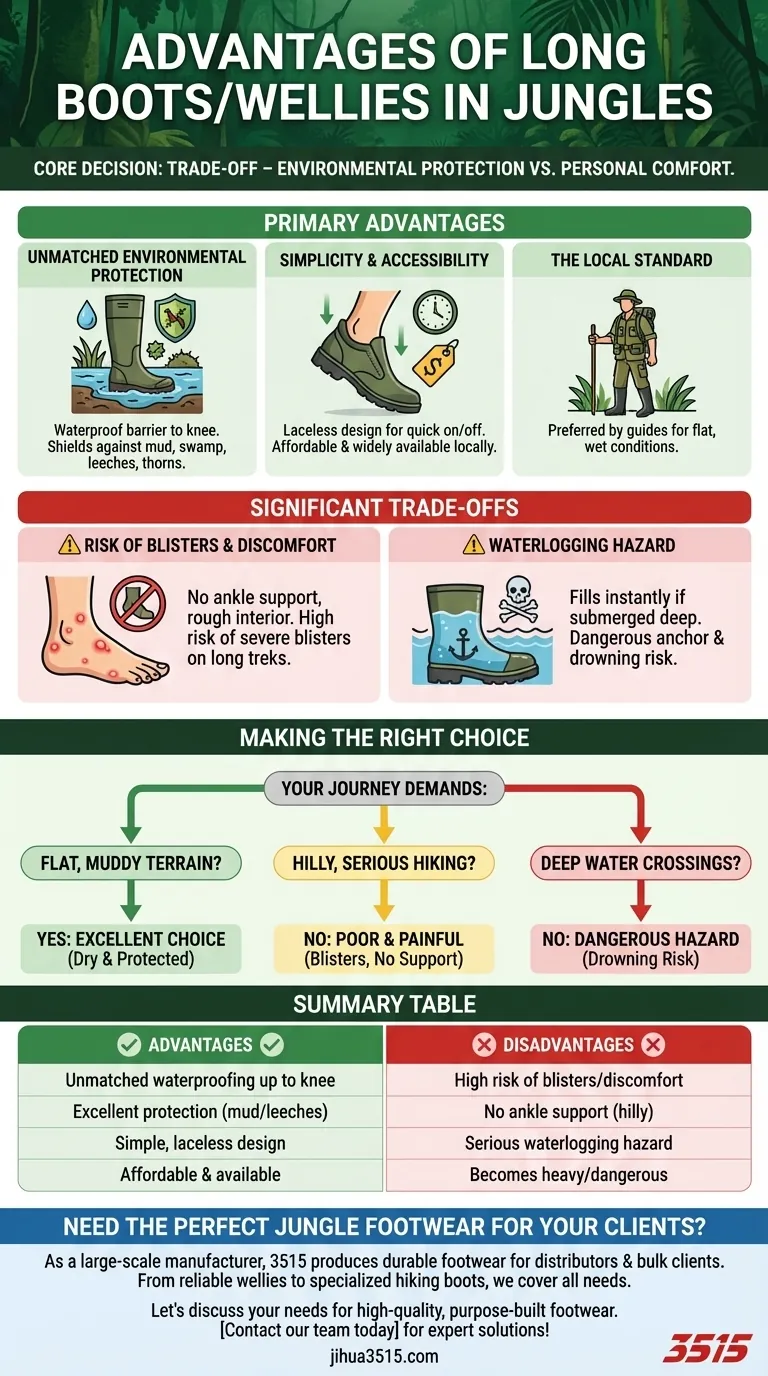In a jungle environment, the primary advantages of long boots, or wellies, are their affordability, widespread availability, and excellent protection against water and mud. They are simple to put on and take off without laces and are the preferred footwear for many local guides due to their practicality in specific conditions.
The core decision to use long boots is a trade-off between environmental protection and personal comfort. They excel at keeping your feet dry in flat, wet conditions but become a significant liability in hilly terrain or deep water situations.

The Primary Advantages in Detail
Unmatched Environmental Protection
Long boots create a waterproof barrier extending up to the knee. This is exceptionally effective for keeping your feet and lower legs dry when walking through mud, swamps, and shallow streams.
This design also provides a physical shield against ground-level hazards like leeches, thorns, and other irritants that are common in dense jungle undergrowth.
Simplicity and Accessibility
One of the most practical benefits is their simple, laceless design. You can slip them on and off in seconds, which is a significant convenience in camp.
Furthermore, long boots are generally inexpensive and can often be purchased locally in regions with jungle environments, making them an accessible option if your primary footwear fails or is unsuitable.
The Local Standard
You will often see local guides and residents wearing long boots. This is a testament to their effectiveness for the specific types of terrain and conditions these individuals encounter daily, which often involve wet and muddy paths rather than steep, technical hiking.
Understanding the Significant Trade-offs
The Risk of Blisters and Discomfort
Long boots offer virtually no ankle support and have a notoriously rough interior. The constant rubbing, especially in hilly terrain or on long treks, is a primary cause of severe blisters.
Proper sock layering is absolutely essential to mitigate this, but even then, they are not designed for the biomechanics of long-distance hiking and can be very hard on your feet.
The Waterlogging Hazard
While they keep water out, they also keep it in. If you step into water deeper than the top of the boot, it will instantly fill up, becoming a heavy, dangerous anchor.
This presents a serious drowning hazard, particularly when crossing rivers or if a small boat were to capsize. This is the single most critical safety drawback to consider.
Making the Right Choice for Your Jungle Trek
To decide if long boots are right for you, analyze the specific demands of your planned journey.
- If your primary focus is short walks on flat, muddy terrain: Long boots are an excellent, practical choice for keeping your feet dry and protected.
- If your primary focus is serious hiking or navigating hilly terrain: Their lack of support and high potential for causing blisters make them a poor and painful option.
- If your journey involves deep water crossings or travel in small boats: The significant drowning risk from waterlogging means you should choose a different type of footwear.
Ultimately, choosing the right footwear requires matching the tool to the specific challenges of your environment.
Summary Table:
| Advantages | Disadvantages |
|---|---|
| Unmatched waterproofing up to the knee | High risk of blisters and discomfort |
| Excellent protection against mud, leeches, and thorns | No ankle support for hilly terrain |
| Simple, laceless design for easy on/off | Serious waterlogging hazard in deep water |
| Affordable and widely available locally | Becomes heavy and dangerous if submerged |
Need the Perfect Jungle Footwear for Your Clients?
As a large-scale manufacturer, 3515 produces a comprehensive range of durable footwear for distributors, brand owners, and bulk clients. Whether you need reliable wellies for flat, wet terrain or specialized hiking boots for rugged jungle treks, our production capabilities cover all types of shoes and boots tailored to your market's demands.
Let's discuss your specific needs and how we can deliver high-quality, purpose-built footwear for your customers. Contact our team today for expert solutions and competitive pricing!
Visual Guide

Related Products
- Safety Footwear Wholesale Manufacturer for Custom OEM/ODM Production
- High Performance Fire-Retardant Waterproof Safety Boots
- Premium Wholesale Waterproof Safety Boots High Performance Protection for Industrial Markets
- Wholesale Safety Footwear Manufacturer for Bulk & Custom OEM Orders
- Factory Direct Wholesale Rain Boots Durable Waterproof & Fully Customizable
People Also Ask
- What are OSHA approved shoes? Understanding the Correct Standards for Workplace Safety
- How long can you wear safety boots? The Lifespan is Determined by Wear, Not Time
- What are the cultural perspectives on wearing shoes in the house? A Guide to Home Etiquette & Hygiene
- What are the differences between steel toe, composite toe, and alloy toe Wellington boots? Choose the Right Safety Toe for Your Job
- How do safety shoes contribute to cost savings for companies? A Strategic Investment in Risk and Cost Management



















